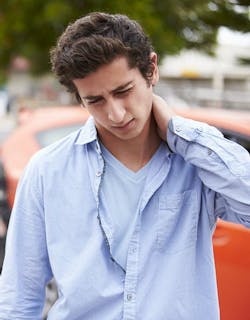
Adolescents pose unique challenges in Adolescent Physical Therapy because of the vast range of therapeutic needs potentially involved. Additionally, conditions presenting in adolescent patients may have lifelong impact or consequences if they are not addressed and corrected as soon as possible. Corrective therapy may incorporate multiple disciplines including: physical therapy, occupational therapy, and speech/language therapy.
At Kernersville Rehab, we specialize in the physical therapy aspects of adolescent rehabilitation. Problems may occur in areas such as muscle tone and strength, balance and coordination, posture and body alignments, joint mobility, gait and movement patterns, neuromuscular function, gross motor development, and motor planning and skills. Therapy techniques may include mobilization, massage, passive and active stretching, muscle strengthening, aquatic therapy, general conditioning and endurance activities.
Postural Problems
As therapists, we see a disturbing increase in the number of teenagers with chronic spine problems and orthopedic related issues that we once associated only with middle aged and older patients. Consider many of our grandparents--shoulders rounding forward, neck flexed with the chin drooping forward over the chest, and an increased slouch of the mid back. Kind of a "C" shape if you will. The same image as the teenager on the sofa or chair, hunched over the computer or video device for hours at a time.
Look closely at the posture of our adolescents today. Sit in any mall and observe them as they sit, walk or stand. Through lack of attention to correct posture, their spinal structures are experiencing premature changes. Over time, these changes become less and less reversible. Muscles and internal organs become adversely affected. A slow, but persistently damaging, domino effect. "In the old days" how many of your parents or grandparents reminded or "nagged" you to sit up straight? These are simple words, but a powerful prescription for better posture and health.
It is essential to intervene as soon as possible. One method, Postural Therapeutic Intervention (PTI) involves a thorough evaluation and assessment of the problem, and a specific plan to correct the posture to minimize it's potential domino effects on the teen's body. Therapeutic measures can start as simple as decreasing the weight in you adolescent's book bag, or adding a daily program of specific, prescribed exercises. Other measures may include modifying where and how youngsters and teens use or sit at computers, video consoles or study desks, posture while sitting watching TV, eating at the table, and so on. If early structural changes have started affecting the spine, muscles or internal organs, additional physical therapy techniques can be helpful. With the assistance of a skilled physical therapist and a "nagging" persistent parent, children can learn to correct the bad habits, perform any prescribed exercises, and adhere to any recommended modifications early enough to prevent permanent problems. These same techniques also apply to postural pain conditions and medical conditions such as scoliosis.
Sports Related Injuries
Today's youth have become an especially unique generation for treating therapists. Modern technology with its video games, text messaging, and computer dominated society has left our adolescents in desperate need of physical activity.
Organized sports are a great way for our teenagers to socialize and exercise; however, the typical adolescent may practice only once or twice per week, then try to play hard during a game on the weekend. Other free time is often spent playing electronic games, watching television, or in other sedentary forms of entertainment. Many schools no longer even have formal exercise programs, so adolescents have virtually no meaningful physical activity on most days. We call this the "weekend warrior syndrome," meaning sudden bursts of very strenuous activity on an infrequent basis. The problem with this is that injuries easily occur when relatively unconditioned teens attempt to play organized sports at higher levels. The most common sports injuries involve the ankle and knee, then the wrist, hand and elbow. Others sites include heel, shin, calf, head, neck and clavicle.
To help prevent the problems resulting from "weekend warrior syndrome," several key concepts must be understood and actively used. The first is to incorporate appropriate daily physical activity to help muscle and cardiovascular endurance--a general conditioning program--to reduce the harmful effects of what would otherwise be strenuous bursts of infrequent activity on the adolescent's body.
The second is to prepare the body adequately to perform the required movements without experiencing injury from strains, sprains, tears, fractures, falls, overuse, etc. Patients may consult with physical therapists preventively (before an injury) to evaluate the physical requirements of the sport(s) and compare those with their current physical capabilities. Any potential problems or risks can be identified and corrected before an injury occurs. On the other hand, if an injury has already occurred, physical therapists can help the patient through both the recovery stage and the rebuilding (strengthening and conditioning) process. This is important so that the adolescent may resume both normal daily activities as well as get ready to safely return to the sport--in better prepared physical condition--without increased risk of re-injury.
In developing an adolescent strengthening/conditioning program, some of the main areas physical therapists address are posture, core stability and balance. Body movements cannot be performed at optimum levels unless proper stability is provided by strong core (trunk) musculature. Injuries can often occur in the extremities due to poor core strength or lack of body stability, especially in children participating in high level athletics. Typically, young or inexperienced athletes may train the superficial musculature, but neglect the deep postural muscles which are just as important. Skilled physical therapists can provide a well balanced program to help adolescents safely perform their sport to the best of their ability, possibly being able to enjoy it more, with less risk of injury, Prevention through preparation first is best, but even if the injury has already occurred, "better late than never."
